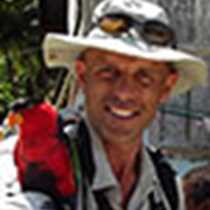Isbukta, Spitsbergen
The strong winds of yesterday had vanished by this morning and a perfectly calm day with clear blue skies greeted us as we arrived in Isbukta. The jagged 3,000 foot peaks of Spitsbergben framed the horizon, in marked contrast to the smoother contours of Edgoya seen yesterday. It was clearly a day for messing about in boats; getting out on the water in something a little smaller than the 289 feet of the National Geographic Endeavour.
It is difficult to judge scale when on board the National Geographic Endeavour. Earlier in the voyage we were fortunate to see one of the largest animals ever to occur on the planet - the blue whale. But a whale watched from the deck of the ship will always be smaller than the National Geographic Endeavour. Even the mighty ice bear appears dwarfed by the vast icescape of a frozen ocean. To really appreciate size and scale it helps to find a different vantage point. To hike out over the land and see people as colourful pinpricks against the shades of tundra green, brown and grey. To sit in a Zodiac that cruises so far from the ship that it becomes difficult to see the ship against the backdrop of glaciers and mountains. Or to paddle a kayak in front of a glacier, hearing only the sounds of crackling ice as gases trapped for centuries are finally released from their pressurized prisons, or the sound of white thunder as the glacier calves tons more ice into the ocean.
To do such things gives us a new perspective on our place in our environment. We are used to living in places where we influence and alter the landscape for our own convenience. After a week in Svalbard it is hard not to be in awe of this place where giant glaciers shape the land and minute Arctic plants find a niche. A place where whales and millions of seabirds find their food in the cold waters of the Barents Sea. And a place where the ice bears rule.
The strong winds of yesterday had vanished by this morning and a perfectly calm day with clear blue skies greeted us as we arrived in Isbukta. The jagged 3,000 foot peaks of Spitsbergben framed the horizon, in marked contrast to the smoother contours of Edgoya seen yesterday. It was clearly a day for messing about in boats; getting out on the water in something a little smaller than the 289 feet of the National Geographic Endeavour.
It is difficult to judge scale when on board the National Geographic Endeavour. Earlier in the voyage we were fortunate to see one of the largest animals ever to occur on the planet - the blue whale. But a whale watched from the deck of the ship will always be smaller than the National Geographic Endeavour. Even the mighty ice bear appears dwarfed by the vast icescape of a frozen ocean. To really appreciate size and scale it helps to find a different vantage point. To hike out over the land and see people as colourful pinpricks against the shades of tundra green, brown and grey. To sit in a Zodiac that cruises so far from the ship that it becomes difficult to see the ship against the backdrop of glaciers and mountains. Or to paddle a kayak in front of a glacier, hearing only the sounds of crackling ice as gases trapped for centuries are finally released from their pressurized prisons, or the sound of white thunder as the glacier calves tons more ice into the ocean.
To do such things gives us a new perspective on our place in our environment. We are used to living in places where we influence and alter the landscape for our own convenience. After a week in Svalbard it is hard not to be in awe of this place where giant glaciers shape the land and minute Arctic plants find a niche. A place where whales and millions of seabirds find their food in the cold waters of the Barents Sea. And a place where the ice bears rule.




